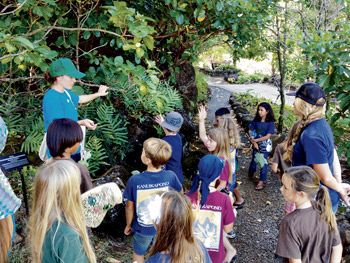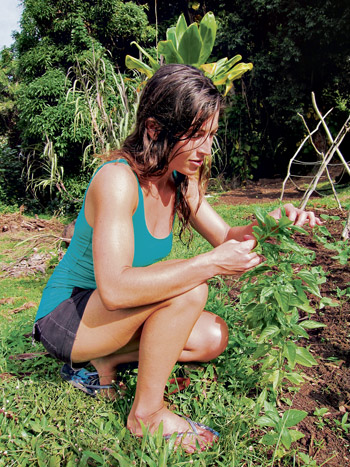Filling The Limahuli Valley Breadbasket

In the garden with third-graders from Kanuikapono Charter school and teacher Taryn Craig. Les Drent photo
“We can teach about plants through the lens of an ahupua’a (land division from mountain to sea),” says the Kaua’i native.
As the North Shore garden’s agriculture and education specialist, Kamen has been teaching keiki about a nature-based lifestyle since February. Children visit the ahupua’a to learn about various practices such as harvesting kalo (taro). They also learn how factors such as climate and tidal fluctuations may affect native practices, so that they can adopt new cultural techniques. For example, native limu (seaweed) currently is being depleted because of over-harvesting, ocean temperature changes and invasive species. In order to adapt to this, keiki learn about harvesting and consuming invasive algae instead.
Kamen also is teaching new methods and techniques for cultivating food sources through a community-supported farm she started at the garden in order to revive the agricultural heritage of the valley.
“This used to be an incredible breadbasket,” she notes.
Kamen not only plants “canoe species” (those brought to the island by the Polynesians), but also has implemented other foods such as kale, beans, lettuce and herbs.
“They are starting to build a relationship with other vegetables,” she says about Native Hawaiian employees at Limahuli Garden and Preserve, whose lineage is traced back to the very North Shore valley they work. “It’s been super-rewarding and fun.”
Because of her efforts, the entire staff of nearly 15 receives food in addition to helping cultivate it.
“It’s been really nice to feed our staff. It’s the way an organization should work if we’re to take care of our ‘ohana,” she says.

Tiana Kamen plucks fresh herbs for lunch from the farm she created at Limahuli Garden and Preserve. Coco Zickos photo
When asked what led Kamen to start the program prior to accepting her new position at NTBG, she says she discovered that one-third of children in Hawai’i were overweight going into kindergarten.
“Which wasn’t making any sense,” she says.
So rather than initiate healthy habits later on in their lives, she wanted them to begin at an earlier age. The program coincides with Hawai’i’s food and seasons.
“It’s giving kids the healthy start they deserve. I just think it’s the greatest gift we can give our keiki,” says the 2004 Island School graduate.
When Kamen was hired at NTBG, she was piloting the program at 19 preschools on Kaua’i. Now, schools across the state are expressing interest.
“Far too often the best and the brightest of Kaua’i’s younger generation are forced to move away to pursue their careers. We’re very proud to have created an opportunity for one of them to stay,” says Limahuli Garden and Preserve director Kawika Winter. “Tiana is the perfect example of the amazing things that can happen within our community when those who are born and raised here go away for college, and then bring their newly gained knowledge back home. They come back and couple that with their passion to effect positive change for our island.”
Kamen says it was nice to return home after graduating with degrees in environmental studies and global international studies from the University of California at Santa Barbara.
“You take what you learn and help give back to the island,” she says.
Kamen is encouraged by the growing awareness in sustainable food growth and hopes even more keiki will visit Limahuli.
“Education is one of the most important parts, and the goal of the garden,” she says.
Helping children understand where healthy food originates from and appreciating nature is her goal, “because the health of our environment is the health of our people,” she says.
Visit ntbg.org for more information.



